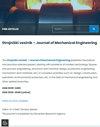Heat Dissipation from Stationary Passenger Car Brake Discs
IF 1.2
4区 工程技术
Q3 ENGINEERING, MECHANICAL
Strojniski Vestnik-Journal of Mechanical Engineering
Pub Date : 2019-12-20
DOI:10.5545/sv-jme.2019.6002
引用次数: 8
Abstract
The paper presents experimental investigation of the heat dissipation from stationary brake discs concentrated on four disc designs, a ventilated disc with radial vanes, two types of ventilated discs with curved vanes - a non-drilled and cross-drilled disc, and a solid disc. The experiments were conducted on a purpose built Thermal Spin Rig and provided repeatable and accurate temperature measurement and reliable prediction of the total, convective and radiative heat dissipation coefficients. The values obtained compare favourably with Computational Fluid Dynamics results for the ventilated disc with radial vanes and solid disc, though the differences were somewhat pronounced for the ventilated disc. The speeds of the hot air rising above the disc are under 1 m/s, hence too low to experimentally validate. However, the use of a smoke generator and suitable probe was very useful in qualitatively validating the flow patterns for all four disc designs. Convective heat transfer coefficients increase with temperature but the values are very low, typically between 3 and 5 W/m2K for the disc designs and temperature range analysed. As expected, from the four designs studied, the disc with radial vanes has highest convective heat dissipation coefficient and the solid disc the lowest, being about 30% inferior. Convective heat dissipation coefficient for the discs with curved vanes was about 20% lower than for the disc with radial vanes, with the cross drilled design showing marginal improvement at higher temperatures.静止客车制动盘的散热
本文对静止制动盘的散热进行了实验研究,主要研究了四种制动盘设计,即径向叶片的通风盘,两种弯曲叶片的通风盘-非钻孔和交叉钻孔盘,以及实心盘。实验在专门建造的热旋实验台上进行,提供了可重复、准确的温度测量和可靠的总散热系数、对流散热系数和辐射散热系数预测。对于带径向叶片的通风盘和固体盘,所获得的数值与计算流体动力学结果比较有利,尽管通风盘的差异有些明显。上升到圆盘上方的热空气的速度低于1米/秒,因此太低,无法通过实验验证。然而,使用烟雾发生器和合适的探头在定性验证所有四种圆盘设计的流动模式方面非常有用。对流换热系数随着温度的升高而增加,但数值非常低,对于所分析的圆盘设计和温度范围,通常在3到5 W/m2K之间。不出所料,四种设计中径向叶片的对流散热系数最高,实心叶片的对流散热系数最低,约差30%。弯曲叶片的对流散热系数比径向叶片的对流散热系数低20%左右,在较高温度下,交叉钻孔设计略有改善。
本文章由计算机程序翻译,如有差异,请以英文原文为准。
求助全文
约1分钟内获得全文
求助全文
来源期刊
CiteScore
3.00
自引率
17.60%
发文量
56
审稿时长
4.1 months
期刊介绍:
The international journal publishes original and (mini)review articles covering the concepts of materials science, mechanics, kinematics, thermodynamics, energy and environment, mechatronics and robotics, fluid mechanics, tribology, cybernetics, industrial engineering and structural analysis.
The journal follows new trends and progress proven practice in the mechanical engineering and also in the closely related sciences as are electrical, civil and process engineering, medicine, microbiology, ecology, agriculture, transport systems, aviation, and others, thus creating a unique forum for interdisciplinary or multidisciplinary dialogue.

 求助内容:
求助内容: 应助结果提醒方式:
应助结果提醒方式:


